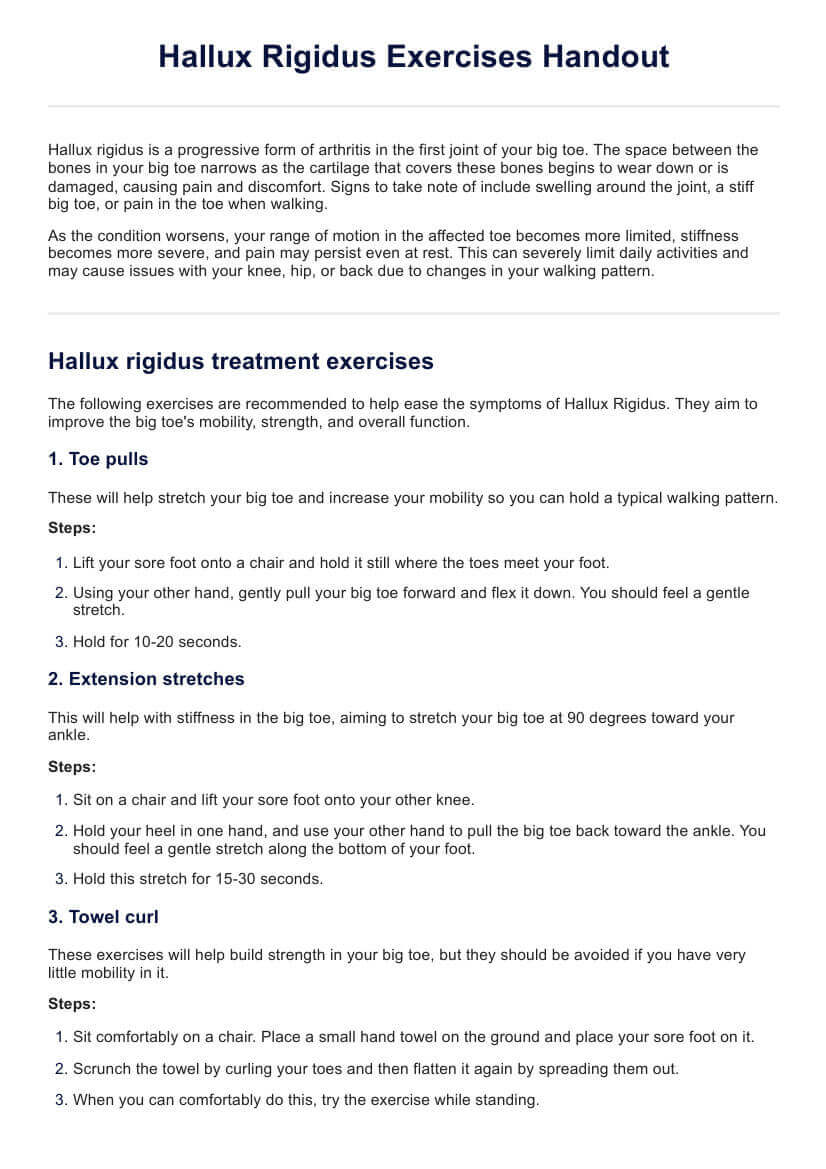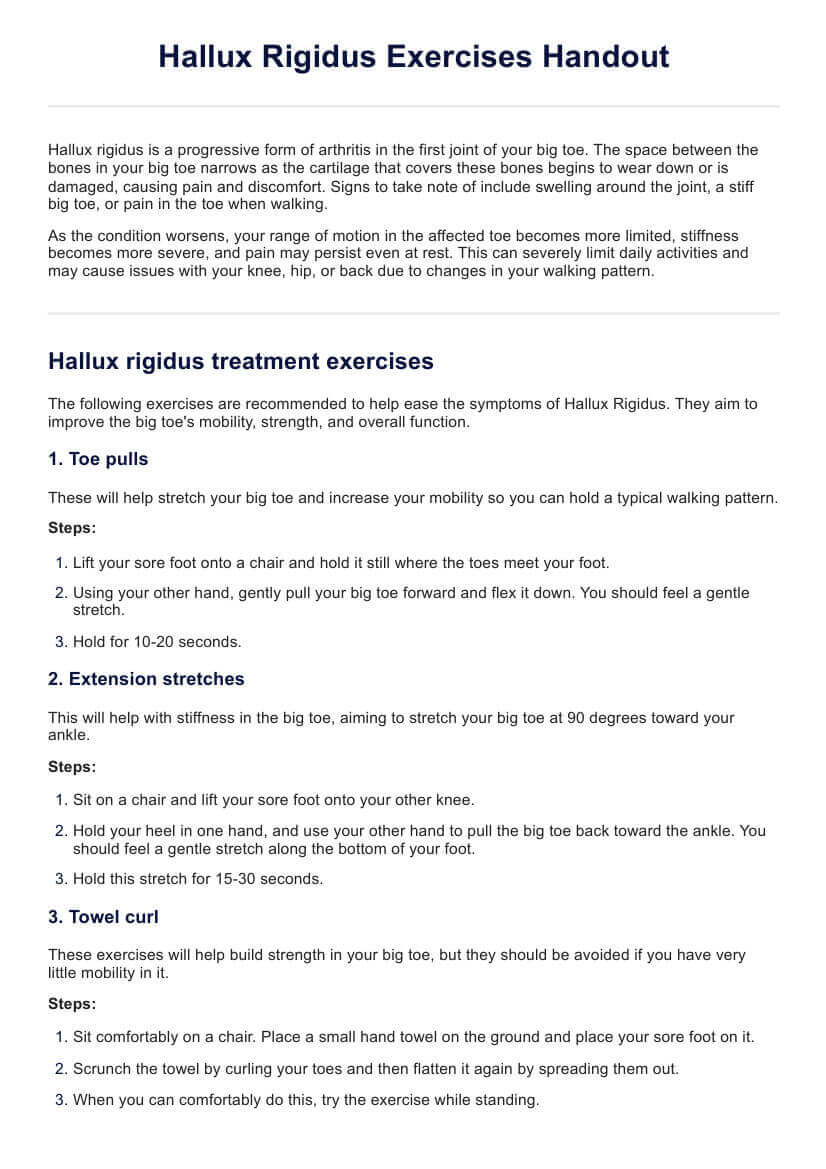Hallux Rigidus Exercises Handout
Discover effective exercises for managing hallux rigidus and download our comprehensive handout to guide your patients towards better mobility and reduced pain.


Importance of hallux rigidus exercises
Engaging patients in hallux rigidus exercises is crucial for healthcare professionals aiming to manage symptoms and improve toe function. These exercises help maintain joint mobility, reduce pain, and strengthen the muscles around the joint, preventing further deterioration. By incorporating these exercises into treatment plans, professionals can enhance patient outcomes, improve daily activity performance, and reduce the likelihood of secondary complications such as gait alterations leading to knee, hip, or back issues.
Remember that consistent exercise is vital to managing hallux rigidus effectively. Incorporating these exercises into physical therapy programs can further enhance patient outcomes.
Hallux Rigidus Exercises Handout Template
Hallux Rigidus Exercises Handout Sample
5 exercises for hallux rigidus
Regularly performing the following exercises can help alleviate the symptoms of hallux rigidus and improve toe mobility and strength.
1. Toe pulls
Toe pulls help stretch the big toe joint, increasing mobility and promoting a normal walking pattern. To perform this exercise, lift the patient’s sore foot onto a chair and hold it still where the toes meet the foot. Using the other hand, gently pull the big toe forward and flex it down, feeling a gentle stretch. Hold this position for 10-20 seconds to enhance flexibility and reduce stiffness.
2. Extension stretches
Extension stretches aim to reduce stiffness in the big toe by encouraging a full range of motion and improving big toe extension. Instruct the patient to sit on a chair and lift the sore foot onto their other knee. Hold the heel in one hand and use the other to pull the big toe back toward the ankle, feeling a gentle stretch along the bottom of the foot. Maintain this stretch for 15-30 seconds to improve joint flexibility and ease pain.
3. Towel curl
The towel curl exercise is designed to build strength in the big toe, which is crucial for maintaining foot function. Strengthening the muscles around the affected joint can help alleviate symptoms of hallux rigidus. Have the patient sit comfortably on a chair with a small hand towel on the ground under the sore foot. Scrunch the towel by curling the toes and then flatten it by spreading them out. Once comfortable, try the exercise while standing to enhance strength further.
4. Toe press, point, and curl
This exercise works the entire foot, offering mobility and strength benefits while keeping the feet flat on the ground. Instruct the patient to sit in a straight-back chair with feet on the floor. Press the toes into the ground, raising the heel, then point the toes while the heel is still raised, and finally, curl the toes under. Hold each position for five seconds and repeat the sequence to improve overall foot function.
5. Toe salutes
Toe salutes focus on stretching the big toe and building strength while maintaining control of the other toes. This exercise can help alleviate big toe pain by improving strength and flexibility. Have the patient sit in a chair with legs at 90 degrees. Raise the big toe off the ground and hold for 5 seconds, keeping the other toes on the floor. Then, lift the other four toes off the ground while keeping the big toe down, and hold for another 5 seconds. Repeat the exercise with the other foot to balance strength and flexibility.
How to use our hallux rigidus treatment exercises handout
Our hallux rigidus treatment exercises handout is designed to help healthcare professionals guide their patients through exercises that can alleviate symptoms and improve toe mobility. Follow these steps to use the handout effectively:
Step 1: Download and review the template
Start by downloading the hallux rigidus treatment exercises handout. Review the exercises to ensure you understand their techniques and benefits.
Step 2: Educate the patient
Explain the importance of these exercises to your patient, including how they can help reduce pain and improve the mobility of the big toe. Conditions like rheumatoid arthritis can contribute to the development of hallux rigidus. Discuss the condition and the expected outcomes of regular exercise.
Step 3: Demonstrate the exercises
Show the patient how to perform each exercise correctly. These exercises are designed to alleviate symptoms of a stiff big toe caused by hallux rigidus. Demonstrate the toe pulls, extension stretches, towel curls, toe presses, point and curls, and toe salutes. Make sure the patient understands the proper form and duration for each exercise.
Step 4: Provide a personalized exercise plan
Based on the patient's specific condition and needs, recommend how often they should perform each exercise and how many repetitions are appropriate. Customize the plan to fit their daily routine and capabilities.
Step 5: Schedule follow-up sessions
Arrange follow-up appointments to monitor the patient’s progress. Adjust the exercise plan as needed based on their improvement and feedback. Provide continuous support and encouragement to help them stay committed to the exercise regimen.
How will professionals benefit from using this handout?
Our Hallux Rigidus Exercises Handout provides multiple benefits for healthcare professionals, enhancing patient care and treatment outcomes.
Improved patient engagement
By providing clear, easy-to-follow exercises, healthcare professionals can engage patients in their treatment plans and encourage active participation and commitment.
Enhanced treatment outcomes
Regular practice of these exercises can help manage hallux rigidus symptoms, improve patient mobility, and reduce pain. Exercises targeting the whole foot can improve overall foot function and relieve pain.
Streamlined patient education
The handout serves as an educational tool, simplifying the explanation of hallux rigidus and the associated exercises, making it easier for professionals to educate patients effectively.
Commonly asked questions
Hallux rigidus is a form of arthritis that affects the first joint of the big toe, causing pain and stiffness due to the narrowing of the space between the bones and cartilage wear.
Symptoms include pain and stiffness in the big toe, swelling around the joint, and difficulty bending the toe. The condition may worsen in cold or wet weather.
Exercises can help improve the mobility and strength of the big toe, reducing pain and preventing the condition from worsening. Regular practice can enhance overall foot function.
The frequency of exercises should be based on individual needs and professional advice. Generally, exercise is recommended by a healthcare provider.







































































































